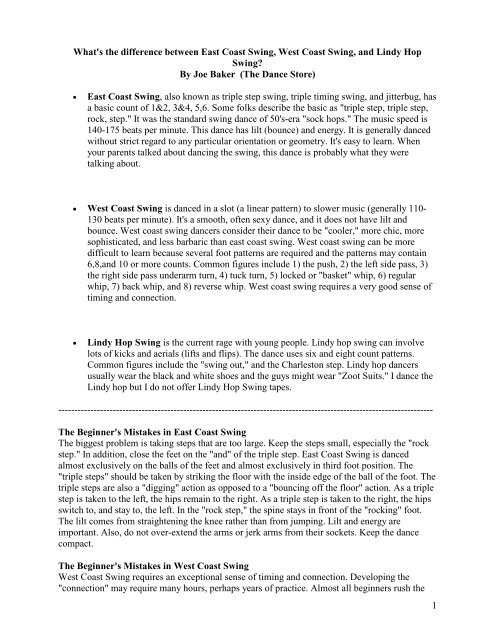What's the difference between East Coast Swing, West - Dance ...
What's the difference between East Coast Swing, West - Dance ...
What's the difference between East Coast Swing, West - Dance ...
Create successful ePaper yourself
Turn your PDF publications into a flip-book with our unique Google optimized e-Paper software.
<strong>What's</strong> <strong>the</strong> <strong>difference</strong> <strong>between</strong> <strong>East</strong> <strong>Coast</strong> <strong>Swing</strong>, <strong>West</strong> <strong>Coast</strong> <strong>Swing</strong>, and Lindy Hop<br />
<strong>Swing</strong>?<br />
By Joe Baker (The <strong>Dance</strong> Store)<br />
�� <strong>East</strong> <strong>Coast</strong> <strong>Swing</strong>, also known as triple step swing, triple timing swing, and jitterbug, has<br />
a basic count of 1&2, 3&4, 5,6. Some folks describe <strong>the</strong> basic as "triple step, triple step,<br />
rock, step." It was <strong>the</strong> standard swing dance of 50's-era "sock hops." The music speed is<br />
140-175 beats per minute. This dance has lilt (bounce) and energy. It is generally danced<br />
without strict regard to any particular orientation or geometry. It's easy to learn. When<br />
your parents talked about dancing <strong>the</strong> swing, this dance is probably what <strong>the</strong>y were<br />
talking about.<br />
�� <strong>West</strong> <strong>Coast</strong> <strong>Swing</strong> is danced in a slot (a linear pattern) to slower music (generally 110-<br />
130 beats per minute). It's a smooth, often sexy dance, and it does not have lilt and<br />
bounce. <strong>West</strong> coast swing dancers consider <strong>the</strong>ir dance to be "cooler," more chic, more<br />
sophisticated, and less barbaric than east coast swing. <strong>West</strong> coast swing can be more<br />
difficult to learn because several foot patterns are required and <strong>the</strong> patterns may contain<br />
6,8,and 10 or more counts. Common figures include 1) <strong>the</strong> push, 2) <strong>the</strong> left side pass, 3)<br />
<strong>the</strong> right side pass underarm turn, 4) tuck turn, 5) locked or "basket" whip, 6) regular<br />
whip, 7) back whip, and 8) reverse whip. <strong>West</strong> coast swing requires a very good sense of<br />
timing and connection.<br />
�� Lindy Hop <strong>Swing</strong> is <strong>the</strong> current rage with young people. Lindy hop swing can involve<br />
lots of kicks and aerials (lifts and flips). The dance uses six and eight count patterns.<br />
Common figures include <strong>the</strong> "swing out," and <strong>the</strong> Charleston step. Lindy hop dancers<br />
usually wear <strong>the</strong> black and white shoes and <strong>the</strong> guys might wear "Zoot Suits." I dance <strong>the</strong><br />
Lindy hop but I do not offer Lindy Hop <strong>Swing</strong> tapes.<br />
---------------------------------------------------------------------------------------------------------------------<br />
The Beginner's Mistakes in <strong>East</strong> <strong>Coast</strong> <strong>Swing</strong><br />
The biggest problem is taking steps that are too large. Keep <strong>the</strong> steps small, especially <strong>the</strong> "rock<br />
step." In addition, close <strong>the</strong> feet on <strong>the</strong> "and" of <strong>the</strong> triple step. <strong>East</strong> <strong>Coast</strong> <strong>Swing</strong> is danced<br />
almost exclusively on <strong>the</strong> balls of <strong>the</strong> feet and almost exclusively in third foot position. The<br />
"triple steps" should be taken by striking <strong>the</strong> floor with <strong>the</strong> inside edge of <strong>the</strong> ball of <strong>the</strong> foot. The<br />
triple steps are also a "digging" action as opposed to a "bouncing off <strong>the</strong> floor" action. As a triple<br />
step is taken to <strong>the</strong> left, <strong>the</strong> hips remain to <strong>the</strong> right. As a triple step is taken to <strong>the</strong> right, <strong>the</strong> hips<br />
switch to, and stay to, <strong>the</strong> left. In <strong>the</strong> "rock step," <strong>the</strong> spine stays in front of <strong>the</strong> "rocking" foot.<br />
The lilt comes from straightening <strong>the</strong> knee ra<strong>the</strong>r than from jumping. Lilt and energy are<br />
important. Also, do not over-extend <strong>the</strong> arms or jerk arms from <strong>the</strong>ir sockets. Keep <strong>the</strong> dance<br />
compact.<br />
The Beginner's Mistakes in <strong>West</strong> <strong>Coast</strong> <strong>Swing</strong><br />
<strong>West</strong> <strong>Coast</strong> <strong>Swing</strong> requires an exceptional sense of timing and connection. Developing <strong>the</strong><br />
"connection" may require many hours, perhaps years of practice. Almost all beginners rush <strong>the</strong><br />
1
eat and move forward automatically before <strong>the</strong> "one" beat. This often results from dancing a<br />
"coaster" step (that is, a back-toge<strong>the</strong>r-forward step) on beats "5&6" ra<strong>the</strong>r than dancing an<br />
"anchor step," as should be danced. Developing <strong>the</strong> feel and <strong>the</strong> connection is difficult without<br />
private instruction. Ano<strong>the</strong>r problem: too much bounce. <strong>West</strong> coast swing DOES NOT have <strong>the</strong><br />
lilt of east coast swing. It's a much smoo<strong>the</strong>r dance than east coast swing<br />
2


